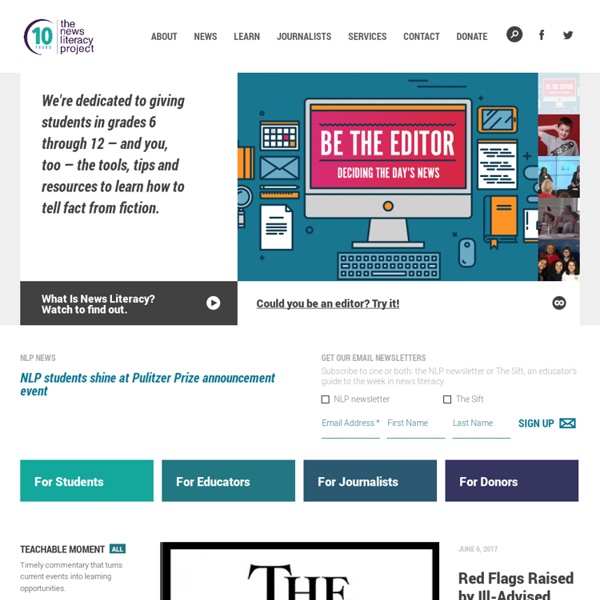



http://www.thenewsliteracyproject.org/
Related: COLLECTION: Media Literacy and Fake News • FAKE NEWS • Fake News/Phishing/Urban Legends and other untruths folderSpecial Report: The Changing Face of Literacy There has never been a generation of young people more immersed in digital media than this one, many of whom learned to use a mobile device before they even started school. This special report examines how literacy instruction is changing in the digital age, from learning to sound out words in elementary school to grappling with “Macbeth” in high school. It finds that, while experts quibble over what it means to be digitally literate, they agree on one thing: even the youngest children should be learning literacy with a mix of print and digital texts. Is the digital revolution transforming literacy instruction in the nation’s schools? Should it? In a new report, Education Week takes a look.
The Definitive List of 176 Fake News Sites on Facebook Fake news is unavoidable. While the idea of “fake news” was born out of the very real instances of fake news stories helping sway the election in favor of now-President Donald Trump, it has since been co-opted by Trump’s administration to be used as a weapon to sow doubt in legitimate media stories that they find unappealing. But real fake news—not the kind Trump likes to point out on Twitter virtually every day—is pervasive. And if you care about reading truthful stories, you need to be on high alert. Facebook, a primary driver of traffic to publications, came under fire late last year for allowing the promotion of fake news sites that deal in conspiracy theories rather than facts.
Fake News - Resources from Harvard Skip to main content Fake News, Misinformation, and Propaganda This page provides background information, links, and tools from outside organizations to help guide users in navigating potential fake news A Visual Take K-12 & Higher Ed. Media Literacy Lesson Plans New Media Tools for Teachers Below, you will find brief explanations of some new media tools, along with links to great sites bursting with ideas for how to use these tools in the classroom. What is it?
How to Protect Students From Fake News For those raised in the information age, life without the internet is no life at all. It is often a primary focus of a teen’s day (75% of teens are online several times per day) and an important means by which they communicate with the world and take in new information. While information can be found in various sources across the internet, an overwhelming majority of teens and pre-teens tend to gather their information from social media sites like Facebook and Twitter. A 2015 report by the Media Insights Project found that the majority of surveyed Millennials (aged 18-34) cited Facebook as their sole or primary source of key news and other information. UM Library Fake News Course The slides for the LOEX 2018 session entitled Fake News, Lies, and a For-credit Class: Lessons Learned from Teaching a 7-Week Fake News Undergraduate Library Course can be seen on the right. An open Canvas version of the course is available as well. Look for a Canvas version of the course in the Commons if you are a Canvas campus. The assignments in the Canvas Commons course take advantage of the integration of Google Drive and Canvas on our campus. See the assignment materials below if the Canvas assignments are unavailable to you.
Stony Brook Center for News Literacy The full News Literacy course, developed at Stony Brook University, organizes the material into 8 concepts that are spread amongst our 14 week course that take students from the first information revolution of Johannes Gutenberg's printing press to the Digital Age of Mark Zuckerberg's Facebook. Each lesson stands alone or can easily be integrated into your program. Below, find a summary of each of those lessons, and a link to the most updated version of the teaching materials for each from our professors at Stony Brook University. Fake News Or Real? How To Self-Check The News And Get The Facts : All Tech Considered Guido Rosa/Getty Images/Ikon Images Fake news stories can have real-life consequences. On Sunday, police said a man with a rifle who claimed to be "self-investigating" a baseless online conspiracy theory entered a Washington, D.C., pizzeria and fired the weapon inside the restaurant. So, yes, fake news is a big problem.
Teacher Assessment Assessment -- Teacher Process for Digital Video With a video project involving so many different steps, it may be easiest to assign a point value for each phase, and then a final point value for the project presentation to the class. There are many assessment rubrics available for project-based multimedia which can be easily modified to fit your personal methods of assessment. You may also try the following online rubric generators to help you create easy, customized rubrics for your projects: E.S.C.A.P.E. Junk News - NewseumED GRADE LEVEL: Middle and high school TIME: 30-60 minutes MATERIALS: E.S.C.A.P.E. Junk News poster (download), E.S.C.A.P.E.: Six Key Concepts worksheets (download), a news story for students to evaluate, internet access Make copies of the E.S.C.A.P.E.
School Library Journal Laura Gardner, 2016 SLJ School Librarian of the Year finalist, updates her lesson plans for the era of fake news. Last week, a new study from Stanford University revealed that many students are inept at discerning fact from opinion when reading articles online. The report, combined with the spike in fake and misleading news during the 2016 election, has school librarians, including me, rethinking how we teach evaluation of online sources to our students.